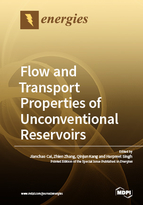Flow and Transport Properties of Unconventional Reservoirs 2018
A special issue of Energies (ISSN 1996-1073). This special issue belongs to the section "H: Geo-Energy".
Deadline for manuscript submissions: closed (31 December 2018) | Viewed by 90598
Special Issue Editors
Interests: porous media; nanofluids; EOR; fractal; capillary pressure; imbibition; mutlphase flow in porous media
Special Issues, Collections and Topics in MDPI journals
Interests: gas separation; CO2 capture; polymeric membrane; membrane separation; membrane contactor; membrane absorption; modeling; membrane preparation; membrane characterization
Special Issues, Collections and Topics in MDPI journals
Interests: flow and transport in porous media; lattice boltzmann method; multiscale modeling; CO2 sequestration; shale gas; energy storage and conversion devices
Special Issues, Collections and Topics in MDPI journals
National Energy Technology Laboratory, Morgantown, WV 26505, USA
Special Issues, Collections and Topics in MDPI journals
Special Issue Information
Dear Colleagues,
Unconventional reservoirs have received a great deal of attention in recent years. A better understanding of the nano- and micro-scale structures of these reservoir rocks, and their transport properties, are critical for improving the efficiency of these energy systems. Due to the complexity of unconventional rocks, and the strong interactions between fluids and pore surfaces due to the reduced dimensionality, conventional approaches are typically not applicable to fluid flow in these porous reservoir rocks. Therefore, the accurate characterization of rocks with nano- to micro-scale pores is challenging and of great importance. We invite investigators to submit original research articles, as well as review articles, which will stimulate the continuous efforts on new and modern methods and techniques for rock characterization and reconstruction, as well as on understanding mechanisms involved in transport physics of tight and ultra-tight porous media and unconventional rocks.
Prof. Dr. Jianchao Cai
Dr. Zhien Zhang
Prof. Dr. Qinjun Kang
Dr. Harpreet Singh
Guest Editors
Manuscript Submission Information
Manuscripts should be submitted online at www.mdpi.com by registering and logging in to this website. Once you are registered, click here to go to the submission form. Manuscripts can be submitted until the deadline. All submissions that pass pre-check are peer-reviewed. Accepted papers will be published continuously in the journal (as soon as accepted) and will be listed together on the special issue website. Research articles, review articles as well as short communications are invited. For planned papers, a title and short abstract (about 100 words) can be sent to the Editorial Office for announcement on this website.
Submitted manuscripts should not have been published previously, nor be under consideration for publication elsewhere (except conference proceedings papers). All manuscripts are thoroughly refereed through a single-blind peer-review process. A guide for authors and other relevant information for submission of manuscripts is available on the Instructions for Authors page. Energies is an international peer-reviewed open access semimonthly journal published by MDPI.
Please visit the Instructions for Authors page before submitting a manuscript. The Article Processing Charge (APC) for publication in this open access journal is 2600 CHF (Swiss Francs). Submitted papers should be well formatted and use good English. Authors may use MDPI's English editing service prior to publication or during author revisions.
Keywords
- porous media
- nano- to micro-scale pores
- rock characterization and reconstruction
- theoretical and numerical models for upscaling unconventional rocks
- hydraulic fracturing and fracture
- dynamic characterization
- capillary flow
- nanofluids non-linear porous flow
- multiphase porous flow
Benefits of Publishing in a Special Issue
- Ease of navigation: Grouping papers by topic helps scholars navigate broad scope journals more efficiently.
- Greater discoverability: Special Issues support the reach and impact of scientific research. Articles in Special Issues are more discoverable and cited more frequently.
- Expansion of research network: Special Issues facilitate connections among authors, fostering scientific collaborations.
- External promotion: Articles in Special Issues are often promoted through the journal's social media, increasing their visibility.
- Reprint: MDPI Books provides the opportunity to republish successful Special Issues in book format, both online and in print.
Further information on MDPI's Special Issue policies can be found here.








